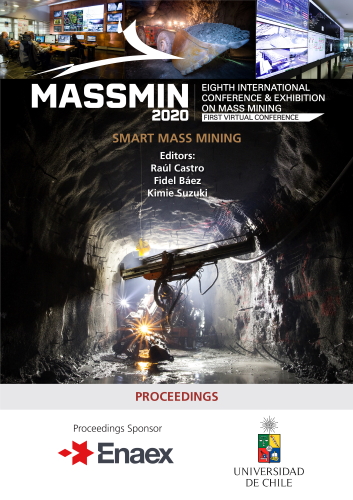Back analysis of cave propagation and subsidence at Cadia East Mine

|
Authors: Ghazvinian, E; Fuenzalida, M; Orrego, C; Pierce, M |
This paper is hosted with the kind permission of Lulea University of Technology, International Conference & Exhibition on Mass Mining, 2024.
DOI https://doi.org/10.36487/ACG_repo/2063_36
Cite As:
Ghazvinian, E, Fuenzalida, M, Orrego, C & Pierce, M 2020, 'Back analysis of cave propagation and subsidence at Cadia East Mine', in R Castro, F Báez & K Suzuki (eds), MassMin 2020: Proceedings of the Eighth International Conference & Exhibition on Mass Mining, University of Chile, Santiago, pp. 535-550, https://doi.org/10.36487/ACG_repo/2063_36
Abstract:
Cadia East panel cave mine is one of the three mines comprising the Cadia Valley Operations, one of Australia’s largest gold mining operations, located in New South Wales. Production at Cadia East commenced in 2013 from Panel Cave 1 (PC1) with its extraction level set at a depth of 1,200 m below the surface. Currently, ore is extracted from PC1 and its neighboring panel (PC2) with an extraction level at 1,400 m depth. A critical component of effective production for Cadia East is successful cave propagation to the surface considering significant cave heights. To ensure cave performance, the rock mass immediately above the footprint of PC1 and PC2 was pre-conditioned by means of hydraulic fracturing (combined with blasting for PC1). Furthermore, a surface hydraulic fracturing program had to be instigated in the hard and competent near surface rock mass above PC1 to assist cave propagation through the final 450 m and its breakthrough to the surface. This paper discusses the significance of using a strain-softening model with the ability to capture the correct mechanics of rock mass frictional strength mobilization for a precise back-analysis of cave performance. IMASS (Itasca Model for Advanced Strain Softening) was used for this study in FLAC3D. IMASS uses two-mode softening yield surfaces. The first residual envelope represents the post-peak strength, and the second residual envelope represents the ultimate rock mass residual strength. The two-mode softening allows for mobilization of high apparent friction angles at low confinement when the blocks are formed in the rock mass. This, in combination with implementation of pre- and post-conditioning of the rock mass (hydraulic fracturing program) in the simulation, were critical in the successful calibration of the model.
References:
Barton, N & Kjaernsli, B 1981, ‘Shear strength of rockfill’, Journal of Geotechnical and Geoenvironmental Engineering, 107(ASCE 16374).
Board, M & Pierce, M 2009, ‘A review of recent experience in modelling of caving, International Workshop on Numerical Modelling for Underground Mine Excavation Design’, June 28 2009, Asheville, in conjunction with the 43rd US Rock Mechanics Symposium.
Bouzeran, L, Pierce, M, Andrieux, P & Williams, E 2019, ‘Accounting for rock mass heterogeneity and buckling mechanisms in the study of excavation performance in foliated ground at Westwood Mine’, In Proceedings of 9th International Conference on Deep and High Stress Mining, Johannesburg, South Africa, June 2019), Australian Centre for Geomechanics.
Cavieres, P, Gaete, S, Lorig, L & Gómez, P 2003, ‘Three-Dimensional Analysis of Fracturing Limits Induced by Large Scale Underground Mining at El Teniente Mine’, In Proceedings of 39th U.S. Rock Mechanics Symposium, Cambridge, Massachusetts (June 2003), pp. 893–900.
Cuello, D & Newcombe, G 2018, ‘Key geotechnical knowledge and practical mine planning guidelines in deep, high-stress, hard rock conditions for block and panel cave mining,’ In Proceedings of the Fourth International Symposium on Block and Sublevel Caving, Australian Centre for Geomechanics, pp. 17-36.
Flores-Gonzalez, G 2019, ‘Major hazards associated with cave mining: are they manageable?’, in J Wesseloo (ed.), Proceedings of the First International Conference on Mining Geomechanical Risk, Australian Centre for Geomechanics, Perth, pp. 31-46.
Harrison, P 2011, ‘Mine Subsidence’, Chapter 8.9 of Society of Mining Engineers Handbook, pp. 627-644.
Itasca Consulting Group, Inc. 2019, FLAC3D — Fast Lagrangian Analysis of Continua in Three Dimensions Ver. 7.0. Minneapolis: Itasca.
Lee, M 2012, Cadia East – Review of Rock Stress Measurements, AMC Consultants Pty Ltd report to Newcrest Mining Limited. AMC 111153: February 2012.
Lowther, RJ, Olivier, L, Lett, JL & Brunton, I 2016, ‘Implementation of a surface-based hydraulic fracturing program to successfully propagate a large cave through hard, competent near-surface rock masses to achieve breakthrough’, in C Carr & G Chitombo (eds), Proceedings of MassMin 2016, pp. 83-96.
Manca, L & Flores, G 2013, ‘Modern planning practices for cave mining’, In Proceedings of the Third International Seminar on Mine Planning, Gecamin, Santiago.
Newcrest 2018, ‘Cadia Expansion Pre-Feasibility Study Findings, Market Release’, pp. 9 [22 August 2018], Available from:
Pappas, D & Mark, C 1993, Behavior of Simulated Longwall Gob Material, Report of Investigations, 9458 USBM.
Pardo, C & Rojas, E 2016, ‘Selection of exploitation method based on the experience of hydraulic fracture techniques at El Teniente Mine’, in C Carr & G Chitombo (eds), Proceedings of MassMin 2016, The Australasian Institute of Mining and Metallurgy, Melbourne.
Sainsbury, BL 2012, A Model for Cave Propagation and Subsidence Assessment in Jointed Rock Masses, PhD thesis, The University of New South Wales, Sydney.
Sainsbury, BL, Sainsbury, DP & Pierce, ME 2011, ‘A historical review of the development of numerical cave propagation simulations’, In Continuum and Distinct Element Numerical Modeling in Geomechanics-2011, Proc. 2nd Int. FLAC/DEM Symp., Melbourne, pp. 14-16.
© Copyright 2025, Australian Centre for Geomechanics (ACG), The University of Western Australia. All rights reserved.
View copyright/legal information
Please direct any queries or error reports to repository-acg@uwa.edu.au
View copyright/legal information
Please direct any queries or error reports to repository-acg@uwa.edu.au
